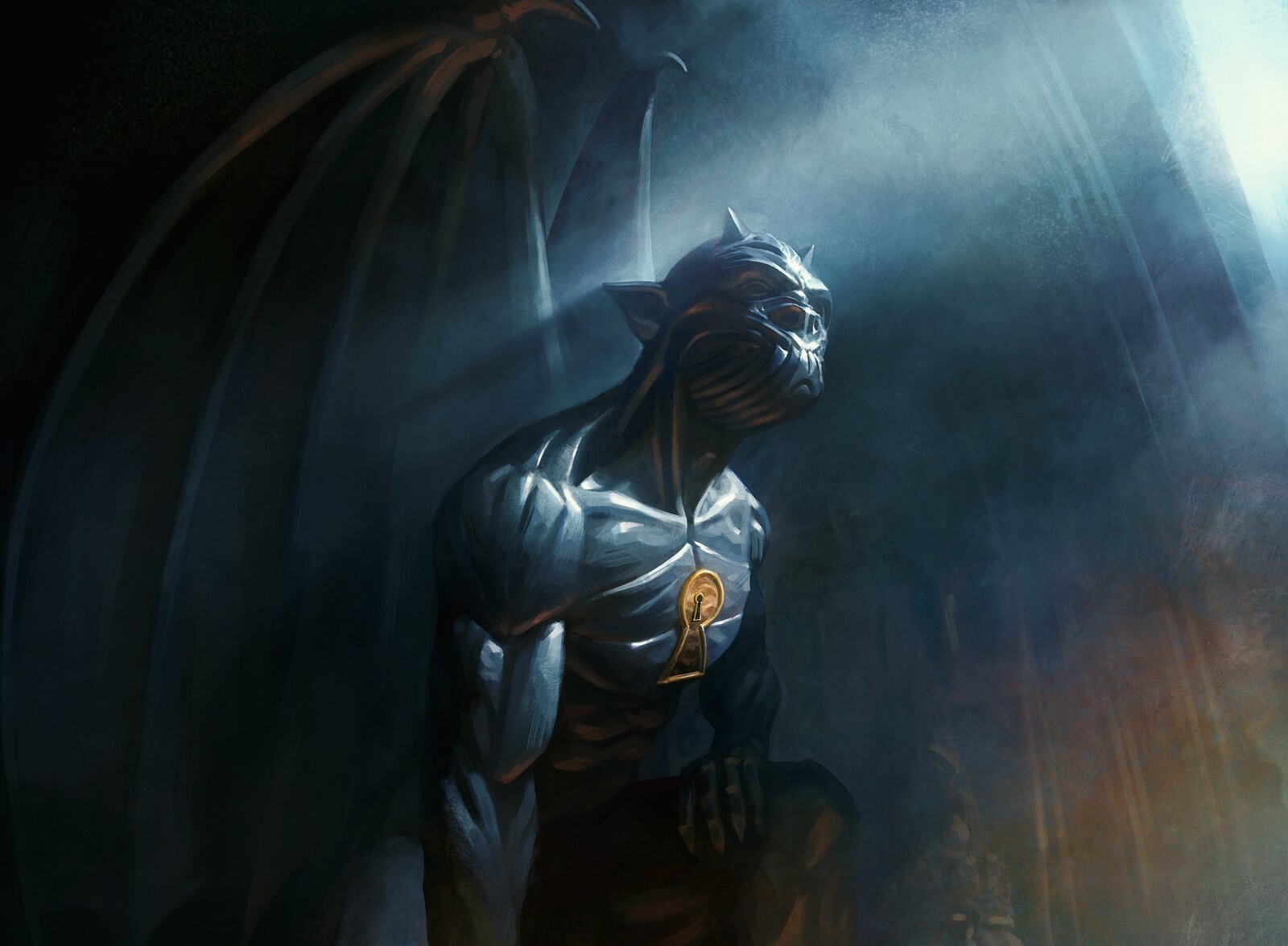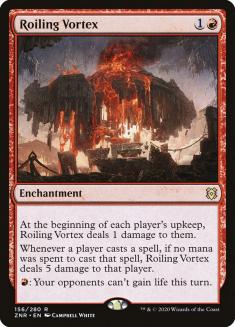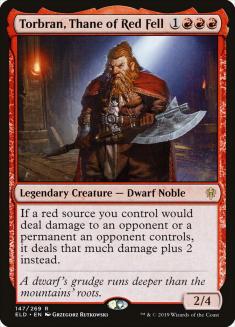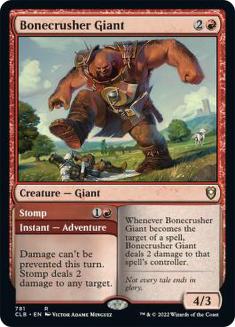Welcome to What We’d Play! With the banning of Uro, Titan of Nature’s Wrath in Standard, many are unsure what they’d play in Zendikar Rising Standard. That’s where we come in and let you know what we’d play and why we’d play it. Hopefully this advice aids in your decision making for your next Zendikar Rising Standard event! Be sure to vote for what deck you would play at the end!
Ryan Overturf — Mono-Red Aggro
Creatures (24)
- 4 Robber of the Rich
- 4 Fervent Champion
- 4 Bonecrusher Giant
- 4 Torbran, Thane of Red Fell
- 4 Akoum Hellhound
- 4 Kargan Intimidator
Lands (3)
Spells (33)
Sideboard

A lot of the discussion around Zendikar Rising Standard right now has had to do with previous Banned List updates and potential future bans. It’s amusing to me that Embercleave is often tossed around as a card that should also go if they ever decide to remove Omnath, Locus of Creation from the format, given that whenever I try to play with the card, all of my opponents destroy all of my creatures, assuming that I don’t just lose to drawing too many Embercleaves in the first place. All that is to say, I have not had success competing in Standard with the ‘Cleave.
That brought me to try something more experimental. I firmly believe that your best shot at beating an Omnath deck on red is leveraging Roiling Vortex, and this deck is largely an experiment in what a deck with four maindeck Vortexes might look like. The Torbran, Thane of Red Fell interaction with Roiling Vortex is incredible given that Torbran’s damage boost only applies to the damage dealt to your opponents, and from there this is a stack of the best red creatures and burn spells currently legal in Standard.
Part of my belief in championing this deck is that a given opponent will be vulnerable to either Roiling Vortex or Bonecrusher Giant, and neither card is bad when you find the wrong matchup. It’s true that you’ll want to sideboard the Vortexes out in aggressive matchups, but if things line up correctly you have a lot of removal to keep them from being able to do too much damage to you themselves.
Roil Eruption has performed better for me than expected so far, in part because it’s just so efficient once you get a Torbran online. Lovestruck Beast is often an issue for red decks and Torbran plus Roil Eruption has been the easiest method for dispatching the Beast that I’ve tried.
All told, there’s a good chance that we should all just jam Omnath piles until we’re told that we can’t anymore, but I’m just not interested in that kind of gameplay. For the time being, I believe this deck is strong against the field and can win games against the Omnath decks.
Bryan Gottlieb — Esper Dance
Lands (19)
Spells (41)

How in the world, after more than a year, did I end up back on Esper Dance? Well, like most things in this Standard format, the answer resolves around Omnath. The removal of Uro, Titan of Nature’s Wrath from the Omnath decks has weakened their ability to go long. Instead, the deck has shifted its focus to either becoming more explosive with Genesis Ultimatum or maximizing a secondary engine with Lucky Clover. Esper Dance has the tools to overcome both approaches.
Rather than attempting the endless grindfests of Orzhov Doom Foretold, Esper Dance shifts to combo-control. A large enough Dance of the Manse can out-scale any resource generation from the Omnath decks, especially when the rest of the deck is challenging that resource generation along the way. Confounding Conundrum may not be an answer to ramp decks, but it is a speed bump that, alongside copious removal, will let you reach the eight-mana breakpoint. Everything here just cycles through cards and keeps you alive. It’s okay to play checkers instead of chess sometimes!
Let me state this even more clearly: Do not add twenty cards and a sideboard Yorion, Sky Nomad to this deck. That’s not what we’re trying to do here. Burn Omen of the Sea aggressively. Don’t hesitate to gain three life with Golden Egg. Stay linear and get rewarded with a great matchup against the format’s boogeyman, and solid plans against control and creature-based decks.
Paulo Vitor Damo da Rosa — Four-Color Ramp
Creatures (9)
Planeswalkers (1)
Lands (16)
Spells (34)
- 5 Forest
- 1 Plains
- 2 Mountain
- 3 Island
- 4 Cultivate
- 3 Mystical Dispute
- 4 Escape to the Wilds
- 3 Genesis Ultimatum
- 2 Spikefield Hazard
- 1 Shatterskull Smashing
- 4 Felidar Retreat
- 2 Thundering Rebuke
Sideboard

Before the Uro ban, I’d say that there was no compelling reason to play anything but Four-Color Ramp. Now that Uro is gone, there are a lot more viable choices; you can still play Ramp, but you can play Adventures (both with and without Omnath), Rogues (either more aggressive or more controllish versions), and even decks like Rakdos Escape or Grixis Control.
Because of this, I’m now worried about tuning my Four-Color Ramp deck too much for the mirror. I think the Ruin Crab version is the best in the mirror, but the card is truly a blank versus a lot of other decks, and you can no longer count on playing the mirror every round. At this point, I think it’s best to build your deck as generically powerful as you can, and accept that you’re going to have a slightly worse matchup versus anyone who has decided they will win the mirror at the expense of the other matchups.
Michael Majors — Dimir Midrange
Creatures (17)
- 1 Vantress Gargoyle
- 2 Brazen Borrower
- 4 Thieves' Guild Enforcer
- 4 Ruin Crab
- 4 Zareth San, the Trickster
- 2 Nighthawk Scavenger
Lands (21)
Spells (22)

In my article today you can read a bit more about how I think the conventional way of building Rogues is flawed, in addition to other musings about this new Standard format.
This deck isn’t perfect but it does a lot of things I like. It can play grindy interactive games between its abundance of removal, countermagic, and heavy hitters like Zareth San and Into the Story to gas back up and snowball the game. It can also just play a decent tempo game with Thieves’ Guild Enforcer and your other non-Crab creatures generating enough pressure to put an opponent off-balance to capitalize with Zareth San. In particularly long contests, Ruin Crab even provides some surprisingly effective inevitability.
Good removal, card draw, counterspells, and tricky ways to keep an opponent off-tempo or capitalize on their mistakes all feel pretty Rogue-like, despite not buying into the entire experience with Soaring Thought-Thief and the rest of the missing cast. So far, that’s how I’m happiest with Rogues — as an expression of a Dimir Midrange deck instead of a tribal beatdown deck with plenty of ways to play fair games and steal others.
Shaheen Soorani — Dimir Control
Creatures (3)
Planeswalkers (7)
Lands (21)
Spells (29)

Dimir Control has been very good to me since the Uro ban. Control always had game against the Simic Elder Giant, but it required additional resources that could have been used elsewhere. This dynamic ended up costing me games, losing to the other powerful threats of the ramp decks after lowering the shields to deal with the reoccurring threat. Now that Uro is no more, this is the control deck to take on the format.
The planeswalker package in this list is top-notch, especially in a format where that card type is rarely utilized. Most of the powerful planeswalkers rotated, but luckily there are some powerful Dimir options left. These, combined with the power of Shark Typhoon, provide the best win condition package that the color combination can offer, in addition to having access to the best removal of the format. If Lotus Cobra exists, black removal is a must and Dimir Control utilizes it best.
Outside of Four-Color Adventures, Dimir Control has great matchups across the field. I hope to play against that tough deck sparingly, while feasting on the rest of the competitive field of Standard.
Cedric Phillips — Mono-Green Aggro
Creatures (28)
- 4 Scavenging Ooze
- 4 Lovestruck Beast
- 4 Stonecoil Serpent
- 2 Yorvo, Lord of Garenbrig
- 2 Syr Faren, the Hengehammer
- 4 Gemrazer
- 4 Swarm Shambler
- 4 Kazandu Mammoth
Lands (18)
Spells (14)

Mono-Green Aggro is back! But how good is it this time around? My answer is… good and trending towards very good given how the metagame is shaping up.
Being without Pelt Collector and having to replace it with Swarm Shambler is a noticeable downgrade as far as getting the game started is concerned, but Kazandu Mammoth is a huge upgrade insofar as you don’t have to play 25 lands anymore because DFCs are dope. Toss in the fact that Kazandu Mammoth alongside Lovestruck Beast make casting The Great Henge (a card I previously hated but I think is better in the current Standard metagame than it was during Core Set 2021 Standard) super-easy to cast on Turn 4, and that’s why you see it maindeck over Garruk’s Harbinger.
Mono-Green Aggro continues to have access to great removal spells in Ram Through and Primal Might, but I’d be careful in how many you start in your maindeck. Yes, killing Lotus Cobra and Omnath is important because both cards are busted, but flooding out on removal is a real thing (especially since control decks are really beginning to establish themselves in the metagame) and can lead to more losses than you think. If you feel like the deck is underperforming, I’d start shaving removal spells for more creatures.
Lastly, it might be time to load up on Chainweb Arachnir given how popular Dimir Rogues is becoming. I’m not saying it’s the end-all-be-all against them but there’s a lot to like there and I wouldn’t be surprised if it’s a better maindeck card over Swarm Shambler as time goes on.
Long story short, Mono-Green Aggro has the tools to be a good deck again but there’s still a lot of work to be done here.
[crowdsignal poll=10620621]





